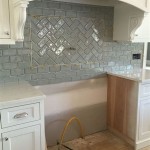Remove Kitchen Wall Split Level
Removing a wall in a split-level kitchen can be a great way to open up the space and create a more modern and inviting feel. However, it's important to note that this is a major renovation project that should only be undertaken by experienced professionals. Here's a step-by-step guide to help you through the process:
1. Assess the Situation
Before you start demolishing any walls, it's important to assess the situation and make sure that removing the wall is feasible. First, you'll need to determine if the wall is load-bearing. Load-bearing walls are essential for the structural integrity of your home, so they cannot be removed without proper support. If you're not sure if the wall is load-bearing, it's best to consult with a structural engineer.
Once you've determined that the wall is not load-bearing, you'll need to make sure that there are no electrical wires, plumbing pipes, or other utilities running through it. If there are, you'll need to have them rerouted before you can remove the wall.
2. Get Permits
Once you've assessed the situation and determined that it's feasible to remove the wall, you'll need to get the necessary permits from your local building department. The permit process can vary from one municipality to another, so it's important to check with your local building department to find out what permits you'll need and how to apply for them.
3. Demolish the Wall
Once you have the necessary permits, you can begin demolishing the wall. The best way to do this is to use a sledgehammer or crowbar to break down the wall into small pieces. Be careful not to damage any of the surrounding walls or ceilings when you're doing this.
Once you've demolished the wall, you'll need to clean up the debris and remove it from your home. You can either do this yourself or hire a contractor to do it for you.
4. Install Support Beams
If the wall you removed was load-bearing, you'll need to install support beams to replace it. Support beams are typically made of steel or wood, and they're designed to carry the weight of the structure above them. The size and type of support beam you need will depend on the size and weight of the structure above it.
To install the support beams, you'll need to cut out the appropriate section of the ceiling and floor. Once the support beams are in place, you can reattach the ceiling and floor to the beams.
5. Finish the Wall
Once the support beams are in place, you can finish the wall. This involves drywalling, painting, and installing any trim or molding that you want. The type of finish you choose will depend on your personal preferences and the overall design of your kitchen.
6. Inspect the Work
Once the wall is finished, it's important to have it inspected by a qualified professional to make sure that it was installed correctly. The inspector will check the wall for any structural problems and make sure that it meets all building codes.
7. Enjoy Your New Kitchen
Once the wall is inspected and approved, you can finally enjoy your new kitchen. The open and airy feel of the space will make it a more enjoyable place to cook, eat, and entertain.

Split Level Wall Removal Traditional Kitchen Minneapolis By Wildwood Kitchens And Baths Houzz

Split Level House Kitchen Remodel Four Generations One Roof

Removing A Kitchen Load Bearing Wall Four Generations One Roof

Load Bearing Wall Removal Split Level Kitchen Remodels

Load Bearing Wall Removal Split Level Kitchen Remodels

Before After Remove The Wall Diy Kitchen Island

Take Down Your Kitchen Wall To Open Up Space Four Generations One Roof Blog

Load Bearing Wall Removal Split Level Kitchen Remodels

7 Best Ideas For Opening Up A Split Level Kitchen

Before After 70 S Split Level Kitchen Transformation The Colorado Nest








